

|
Timid new World - oh baby! I wanna be your backdoor man!
By Capt Wardrobe Nov 2020
Future Shock!
A SMART NEW 911?
and now; a creepy look into our future as predicted by Bilderbergers
|
|
|
"The trends for future development are clear. We are digitising the world around us into binary 1s and 0s, as we — the humans — are also now forming part of the new big data layer"
[The Raconteur - The City in 2030] |
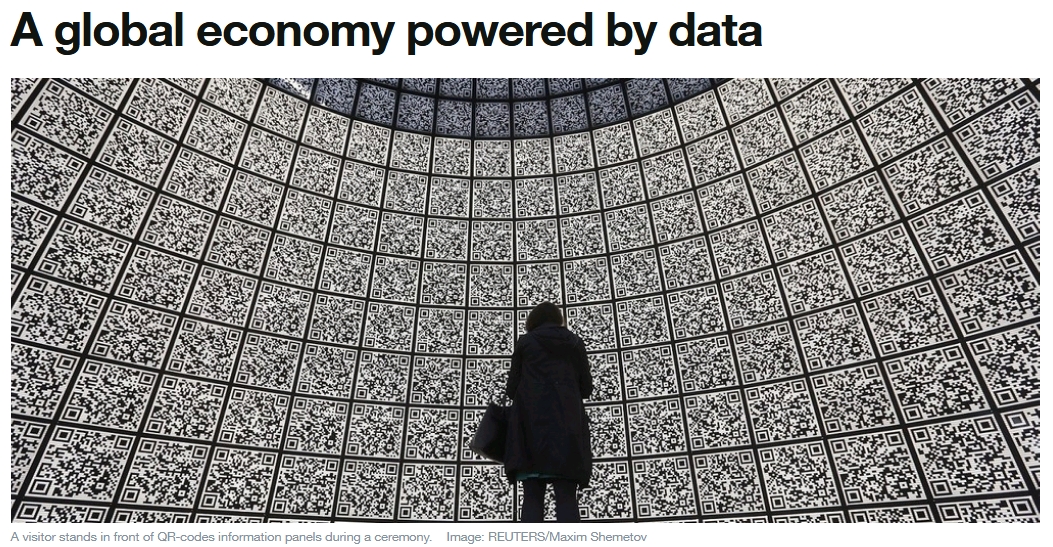 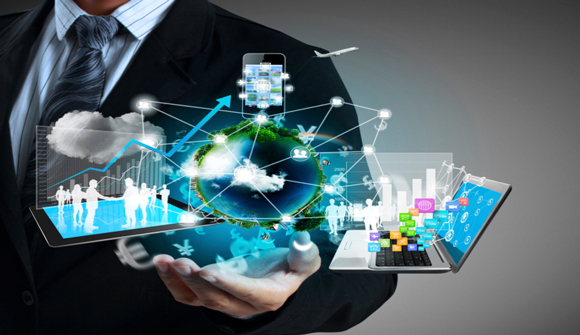 |
The Smart City of 2030
[from 2017] -
Smart cities are already with us. We have already brought huge advances to the way we manage our civic utilities with software-based intelligence to control civil engineering infrastructures. This insight allows workers in white shirts and ties across operations departments to perform predictive supply optimisation for us.
This same insight also allows engineering staff in hard hats to perform physical predictive maintenance and keep machines online longer. Things work better now.
We can already control traffic flows with cameras and smart traffic lights that have a degree of computer reasoning power. We also can construct buildings with smart meters for power monitoring and the ability to run subdued lighting in unpopulated zones. All this has happened, already.
Further still, we can now build new city areas using geographic information systems (GISs) from organisations such as Esri to create 3D mapping plans of everything from skyscrapers to parklands. Using data rich 3D maps of buildings, factories and homes, we can use computers to create so-called “digital twins” of rooms, power plants and the turbines inside them, or whole airports.
These digital twins are working visualisations of the real world, programmed to exist in the correct context of their physical existence; for every smart city, there is a software-based version of it sitting on a computer server. This is the bleeding edge; this is happening now.
|
|
Digital Twinning - real time surveillance of everything
In simple terms, Digital Twinning is a process in which a physical object, system or a being is recreated on a virtual interface.
During this stage, a fully developed digital replica is constructed in order for it to be used for future testing, development, and experimentation.
Simply put, it is a digital replica or a clone that provides its manufacturers with the ability to interact with it on a digital platform instead of executing tests on the real physical “twin” in reality.
|
The fourth wave in industry, known as Industry 4.0, is underway connecting the physical world to the digital. To bring these together, manufacturers are developing smarter, better-connected machines that use big data, machine-to-machine communication and machine-learning technology to optimise productivity.
Digital twinning, the mapping of a physical asset to a digital platform, is one of the latest technologies to emerge from Industry 4.0. It uses data from sensors on the physical asset to analyse its efficiency, condition and real-time status. Up to 85 per cent of internet of things platforms will contain some form of this by 2020
Racontuer
|
|
Post offices act as a central hub for analogue public communications & goods delivery... They are also usually where a government puts its human intelligence data collection people. |
|
It's been fairly well publicised that Spy agencies
Peter Wright in his book SpyCatcher wrote about working with the Post Office & even asserted that they had a back room in every major city working for The UKs secret service [MI] -
...in 1947 he [Wright] was given a job as Navy Scientist, attached to the Marconi Company were he worked alongside his father on developments in the field of radar and anti-submarine warfare.
In 1949, whilst working at the Marconi Company, he started working part-time for UK intelligence (MI5), along with engineers of the General Post Office (GPO)
hmmm Marconi? see also Dead Scientists
-
In the 1980,s over two dozen science graduates and experts working for Marconi or Plessey Defence Systems died in mysterious circumstances, most appearing to be 'suicides.' The MOD denied these scientists had been involved in classified Star Wars Projects and that the deaths were in any way connected.
Similarly AT&T had a scandal where it 'permitted' NSA eavesdropping rooms as well.
How's that for a Public / Private partnership?
Room 641A is a telecommunication interception facility operated by AT&T for the U.S. National Security Agency, as part of its warrantless surveillance program as authorized by the Patriot Act. The facility commenced operations in 2003 and its purpose was publicly revealed in 2006. - WikiPedia
|
|
AI and Control
Artificial intelligence (AI) is being used as a tool to support the fight against the viral pandemic that has affected the entire world since the beginning of 2020. The press and the scientific community are echoing the high hopes that data science and AI can be used to confront the coronavirus
|
|
The Die Hard Fire Sale - The Ultimate Backdoor attack
A Fire Sale is an all-out cyberwarfare attack that performs a three-stage systematic attack on a nation's computer infrastructure. Hackers called it Fire Sale because "Everything must go".
That operation was used by terrorist mastermind Thomas Gabriel and his group of cyber-terrorists. It was a major part of the fourth Die Hard film, Live Free or Die Hard.
Three Stages of A Fire Sale
Stage 1: Shutting down all transportation systems; such as traffic lights, railroad lines, subway system and airport systems.
|
|
2010 - who has the Keys to the Internet?
It’s a story straight out of a Dan Brown novel: Seven people from across the globe have been chosen to hold the keys to the Internet.
The key holders are from the U.S., U.K., Burkina Faso, Trinidad and Tobago, Canada, China and the Czech Republic, ensuring that no one person — or nation — will hold all the power.
In the event of a terrorist or other attack on the Internet, the key holders will be flown to an undisclosed location in the U.S. Each key contains a fragment. If at least five are united, they will form a master key that can restore the Internet.
[snip]
“More has happened here today than meets the eye,”said Vinton Cerf, a former program manager with the Department of Defense who’s now with Google and goes by the galactic street name of “Father of the Internet.” “An infrastructure has been created for a hierarchical security system which can be purposed and repurposed in a number of different ways,” he said, practically writing the Hollywood script. |
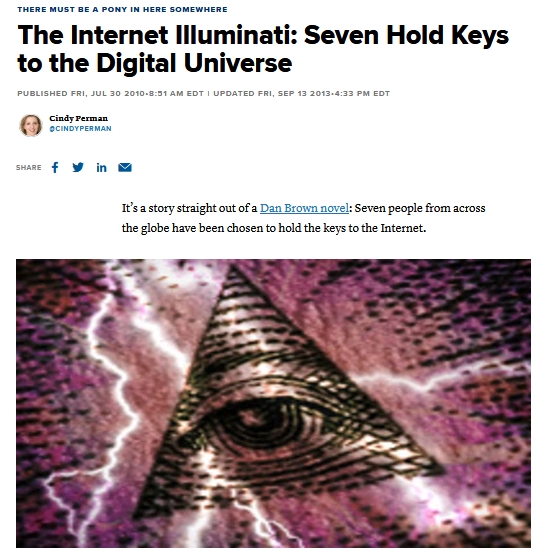 |
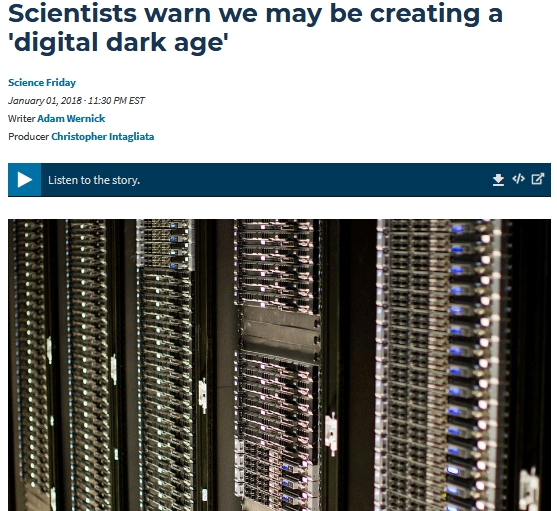 |
Digital Dark age?
“We may [one day] know less about the early 21st century than we do about the early 20th century,” says Rick West, who manages data at Google. “The early 20th century is still largely based on things like paper and film formats that are still accessible to a large extent; whereas, much of what we're doing now — the things we're putting into the cloud, our digital content — is born digital. It's not something that we translated from an analog container into a digital container, but, in fact, it is born, and now increasingly dies, as digital content, without any kind of analog counterpart.”
Computer and data specialists refer to this era of lost data as the "digital dark ages." Other experts call the 21st century an “informational black hole,” because the digital information we are creating right now may not be readable by machines and software programs of the future. All that data, they worry — our century’s digital history — is at risk of never being recoverable.
Surprisingly, many of the world’s largest companies and data-based enterprises still rely on an old storage medium: magnetic tape. In 1952, IBM introduced the first magnetic tape data storage system, ushering in the modern era of electronic computing.
|
|
[snip]
Lauren Young says some researchers see hope in one of the newest technologies: DNA storage.
“Basically, researchers have found a way to store data onto DNA, which is a billion-year-old molecule that can store the essence of life,” Young explains. “It's pretty incredible that they can do that. It's all synthetically made; it’s not genomic DNA.”
In this case, storage capacity is measured in petabytes; that is, millions of gigabytes. Science Magazine writes: “A single gram of DNA could, in principle, store every bit of datum ever recorded by humans in a container about the size and weight of a couple of pickup trucks.”
|
|
Progress on molecular data storage system
Date:
February 4, 2020
Source:
Brown University
A team of Brown University researchers has made substantial progress in an effort to create a new type of molecular data storage system.
In a study published in Nature Communications, the team stored a variety of image files -- a Picasso drawing, an image of the Egyptian god Anubis and others -- in arrays of mixtures containing custom-synthesized small molecules. In all, the researchers stored more than 200 kilobytes of data, which they say is the most stored to date using small molecules. That's not a lot of data compared to traditional means of storage, but it is significant progress in terms of small molecule storage, the researchers say.
|
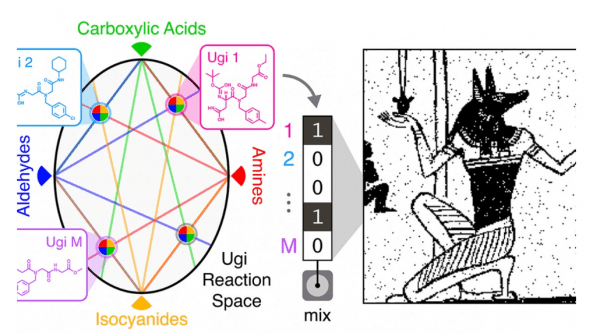 |
|
"I think this is a substantial step forward," said Jacob Rosenstein, an assistant professor in Brown's School of Engineering and an author of the study. "The large numbers of unique small molecules, the amount of data we can store, and the reliability of the data readout shows real promise for scaling this up even further."
As the data universe continues to expand, much work is being done to find new and more compact means of storage. By encoding data in molecules, it may be possible to store the equivalent of terabytes of data in just a few millimeters of space. Most research on molecular storage has focused on long-chain polymers like DNA, which are well known carriers of biological data. But there are potential advantages to using small molecules as opposed to long polymers. Small molecules are potentially easier and cheaper to produce than synthetic DNA, and in theory have an even higher storage capacity.
The Brown research team, supported by a U.S. Defense Advanced Research Projects Agency (DARPA) grant led by chemistry professor Brenda Rubenstein, has been working to find ways of making small-molecule data storage feasible and scalable.
|
|
As the 4th Industrial revolution evolves, this will morph into wearble tech, implants [example; Elon Musks Neuralink]
Eventually one could see; as the Biosecurity agenda furthers the 4th industrial revolution, a lead into
Will there be a backdoor to these micro machines in your body?
[see here also; nanotechnology-in-military-development]
|
Happening NOW! - Covid 19 - RNA Backdoor
‘They are going to hack the cells in your body in order to make them into drug factories’,
‘The problem is with this approach is there’s never been an approved mRNA product’.
Nathan Vardi, - staff writer for Forbes, Why Pfizer Is Betting Big on an Unproven Treatment for Covid-19, from March 2020.
In the past few years, there has been increasing focus on the use of messenger RNA (mRNA) as a new therapeutic modality. Current clinical efforts encompassing mRNA-based drugs are directed toward infectious disease vaccines, cancer immunotherapies, therapeutic protein replacement therapies, and treatment of genetic diseases. However, challenges that impede the successful translation of these molecules into drugs are that
(i) mRNA is a very large molecule,
Although some of these challenges have been partially solved by means of chemical modification of the mRNA, intracellular delivery of mRNA still represents a major hurdle. The clinical translation of mRNA-based therapeutics requires delivery technologies that can ensure stabilization of mRNA under physiological conditions.
Opportunities and Challenges in the Delivery of mRNA-based Vaccines
(ii) it is intrinsically unstable and prone to degradation by nucleases, and
(iii) it activates the immune system.
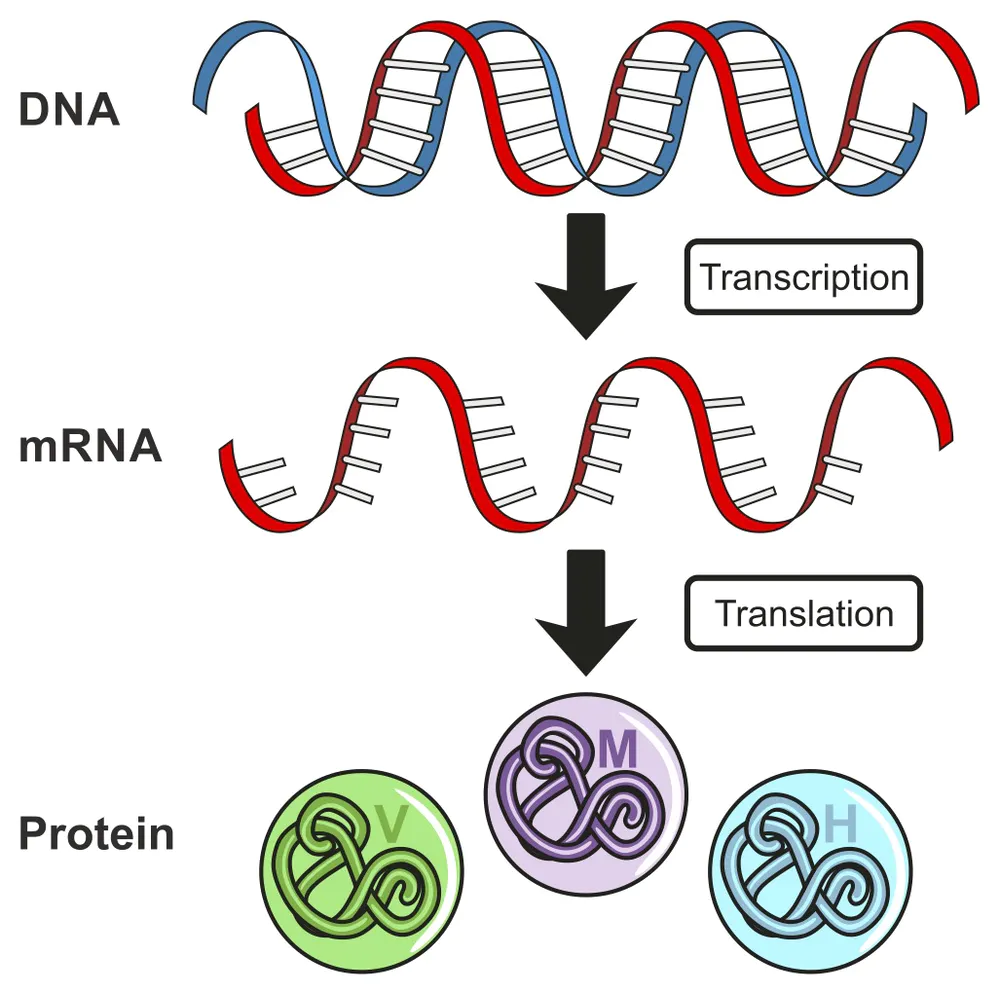
|
"...the Pfizer/BioNTech vaccine has a major downside to it. Pfizer and Moderna have stated that their mRNA vaccines need to be kept at -70° C and -20° C, respectively, which is a significant logistical challenge. Without these extremely cold temperatures, the mRNA and combined nanoparticles will lose their integrity. There are no studies on the effect of poorly stored mRNA vaccines on the human body. In comparison, DNA vaccines are much easier to transport and store as they are much more stable molecules.
As we have seen, the potential for mRNA technology is boundless. If the vaccine is successful in normalising the process of gene editing for medicinal benefit, there will be pressure to continue editing genes in other ways. It isn’t hard to see that the technology could have cosmetic, medical, and military applications that could range from phosphorescent skin to military bioweapons beyond our imagination. That is the reason why the people behind this technology are reluctant to speak about its potential game-changing mRNA method, for it represents our first real steps into transhumanism."
|
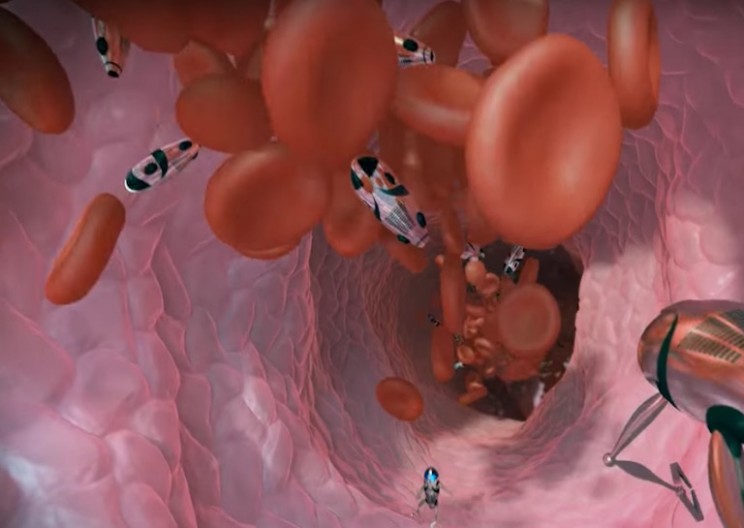 |
Rise of the Nanobots
In the next 10 or so years, your blood will probably be streaming with tiny nanorobots there to help keep you from getting sick or even transmit your thoughts to a wireless cloud. They will travel inside of you, on a molecular level, protecting the biological system and ensuring that you have a good and long life. The future is closer than you may think.
Nano as a term is no longer perceived as special; we got used to small devices and artificial intelligence in our daily life. Tech has developed significantly and so have potential applications of these microscopic machines.
Google's director of engineering, Ray Kurzweil, is an avid predictor of future events and claims to have a fairly high accuracy rate. He is one of the biggest proponents of the notion that nanobots will be streaming through our blood in the near future. The idea surrounding this prediction isn't that far off from modern technology.
|
|
The Cult leadership of Slavemasters want to control, track, trace everything.
and, with what we have seen in the past.
They have every intention of hacking your Nervous system & building a back door into our brains.
Manipulating our perception of reality even further than they are doing now.|
2018 - Dr. James Giordano, Chief of the Neuroethics Studies Program and Scholar-in-Residence in the Pellegrino Center for Clinical Bioethics at Georgetown University, speaks to cadets and faculty about how advancements in neuroscience and neurotechnology will impact the future of war. This event was hosted by the Modern War Institute at West Point. -
YouTube
"Sixteen coded categories of prisoners were listed in columns 3 and 4
hole 3 signified homosexual,
hole 9 for anti-social,
hole 12 for Gypsy.
Hole 8 designated a Jew.
Column 34 was labeled 'Reason for Departure.'
Code 2 simply meant transferred to another camp for continuing labor.
Natural death was coded 3.
Execution was coded 4.
Suicide coded 5.
The ominous code 6 designated 'special handling,' the term commonly understood as extermination "
The Dark Roots of Bayer, BASF, Hoechst and IG Farben Industrie AG/amp
"The trends for future development are clear.
“But for those of us who have thrown off the myth of the machine, the next move is ours: for the gates of the technocratic prison will open automatically, despite their rusty ancient hinges, as soon as we choose to walk out.”
|